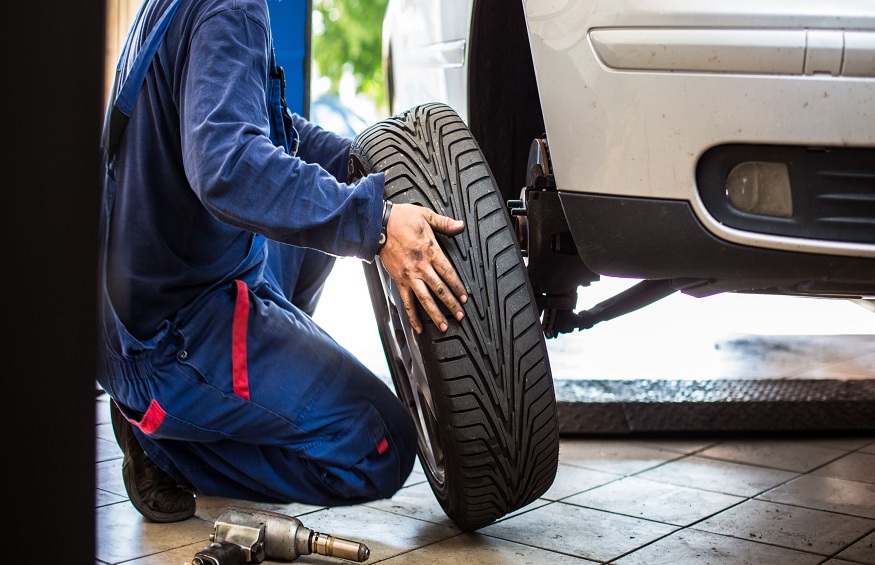The Highway Code requires you to change the tires as soon as the wear indicator with a height of 1.6 mm is reached, but nothing prevents you from changing them before. Whether an alert has come on on the dashboard or you have noticed the degradation of your tires yourself, if the tread depth is less than 3 mm, it is time to think about choosing new tires.
Choosing your tires wisely: all our advice
Like all consumer goods, tires are standardized on a European scale. This “label” includes various essential information which makes it possible to assess the quality of the product offered according to different criteria:
Fuel consumption, subdivided into six classes from A to G, translated by the rolling resistance of your tires which generates more or less significant consumption.
The quality of wet braking, divided into five classes from A to F, determined through a test which consists of emergency braking at 80 km/h and measuring the braking distance. A indicating short braking and F braking of lower quality because it takes longer.
And finally, the rolling noise indicated in dB. It’s that kind of “resonance” that annoys you so much when you drive!
These “standard” elements established, all you have to do is identify the size of your tires and define which “season” will be your favorite.
1- Choose the right tire size for your vehicle
As a general rule, to choose your tires – at least their dimensions – you can refer to the manufacturer’s information and be satisfied with that. Failing that, you just need to know how to “read” the indications on their side to determine the appropriate models.
225 represents the width, 50 the height, R for Radial, 16 the diameter, 92 the load index. This all gives you a “V” speed factor.
Indicated on the tires, the load and speed indices are adapted to the weight and power of each vehicle when it is approved. The speed index reflects the maximum speed that the tire can reach. This maximum speed corresponds to that of your vehicle. If you can fit load and speed indices higher than those of your original tires, it is absolutely prohibited and dangerous to fit lower indices.
These first indications give you a “size” reference perfectly suited to your vehicle. You will still have to choose the “season” and the “type” of tires.
Caradisiac advice – The tire is the only element that connects you to the road, so do not try to innovate and pay attention above all to your safety. Follow the manufacturer’s recommendations, which you can easily find on the internet by simply entering the registration number of your vehicle.
2- Choose the “season” carefully
There are three categories of “seasons”: summer, winter and 4 seasons (or “all weather”). Winter is subdivided, for those of you who live in regions with high levels of snow, between studded tires or so-called “Nordic” tires.
The so-called “summer” tire is the most classic, its price varies from €28 to more than €300 depending on the size, brand and quality.
“Dry ground” and “wet ground”? These subdivisions imply the grip of the tire which can vary from 1 to 10 depending on the quality of the road surface which, in France, is deteriorating more and more, the design of the tire profile, but above all the conditions climatic.
The ideal on dry ground would be to ride with smooth “slick”, type F1, extra-wide tires, because the more surface there is in contact with the ground, the better the grip. This type of tire being prohibited “on the road”, equipment manufacturers invented semi-slick tires. Equipped with a few grooves, they offer excellent grip legally. With them, you will have the impression of “sticking” to the road.
As soon as it rains, it is the tire’s ability to quickly evacuate water to avoid aquaplaning that takes precedence. This capacity depends on the size of the sculptures (drawing). In pouring rain, V-shaped sculptures are by far the most effective. But what you gain by avoiding aquaplaning is detrimental to grip, as the tread is reduced by the importance of the tread pattern. Once again it’s a choice: grip on dry ground or anti-aquaplanning on wet ground!
Caradisiac advice – The summer tire offers optimal performance on dry or wet roads. This is the tire to choose if your summers are very hot, with temperatures around 40° for prolonged periods. On the other hand, it is not able to withstand temperatures below 7°C.
3- season tires: the ideal partner
The “4 seasons” envelopes are intended to allow you to drive all year round without having to switch between summer and winter tires. The 4-season tire is a hybrid that combines the qualities of a summer tire and a winter tire and is an ideal road partner if you drive most often in a region that requires an operating range of – 10° to + 30 °C. Outside of this zone, they will be less efficient than dedicated “summer” or “winter” tires, but unless you are driving in snow or on ice (and even then), the differences with the latter are however hardly perceptible.
Their price is also no longer a barrier because although they are in the range of €78 to €300, high-end summer tires are just as expensive.
There are 3 fundamental differences between summer tires and winter tires: their structure, their rubber content and their tread pattern. As for their price… the range again is between €68 and €300.

